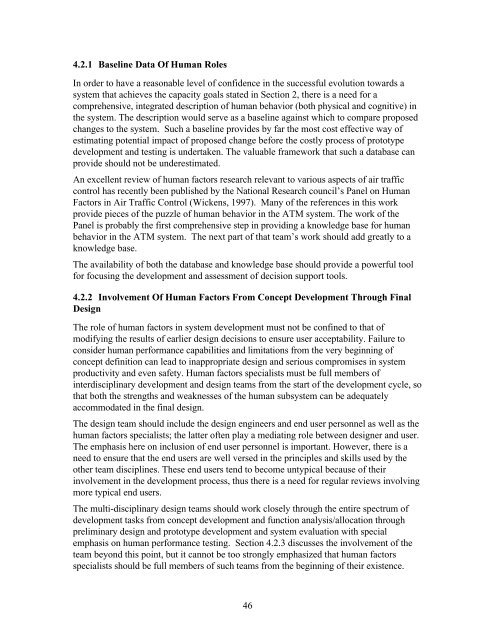Air Traffic Management Concept Baseline Definition - The Boeing ...
Air Traffic Management Concept Baseline Definition - The Boeing ...
Air Traffic Management Concept Baseline Definition - The Boeing ...
You also want an ePaper? Increase the reach of your titles
YUMPU automatically turns print PDFs into web optimized ePapers that Google loves.
4.2.1 <strong>Baseline</strong> Data Of Human Roles<br />
In order to have a reasonable level of confidence in the successful evolution towards a<br />
system that achieves the capacity goals stated in Section 2, there is a need for a<br />
comprehensive, integrated description of human behavior (both physical and cognitive) in<br />
the system. <strong>The</strong> description would serve as a baseline against which to compare proposed<br />
changes to the system. Such a baseline provides by far the most cost effective way of<br />
estimating potential impact of proposed change before the costly process of prototype<br />
development and testing is undertaken. <strong>The</strong> valuable framework that such a database can<br />
provide should not be underestimated.<br />
An excellent review of human factors research relevant to various aspects of air traffic<br />
control has recently been published by the National Research council’s Panel on Human<br />
Factors in <strong>Air</strong> <strong>Traffic</strong> Control (Wickens, 1997). Many of the references in this work<br />
provide pieces of the puzzle of human behavior in the ATM system. <strong>The</strong> work of the<br />
Panel is probably the first comprehensive step in providing a knowledge base for human<br />
behavior in the ATM system. <strong>The</strong> next part of that team’s work should add greatly to a<br />
knowledge base.<br />
<strong>The</strong> availability of both the database and knowledge base should provide a powerful tool<br />
for focusing the development and assessment of decision support tools.<br />
4.2.2 Involvement Of Human Factors From <strong>Concept</strong> Development Through Final<br />
Design<br />
<strong>The</strong> role of human factors in system development must not be confined to that of<br />
modifying the results of earlier design decisions to ensure user acceptability. Failure to<br />
consider human performance capabilities and limitations from the very beginning of<br />
concept definition can lead to inappropriate design and serious compromises in system<br />
productivity and even safety. Human factors specialists must be full members of<br />
interdisciplinary development and design teams from the start of the development cycle, so<br />
that both the strengths and weaknesses of the human subsystem can be adequately<br />
accommodated in the final design.<br />
<strong>The</strong> design team should include the design engineers and end user personnel as well as the<br />
human factors specialists; the latter often play a mediating role between designer and user.<br />
<strong>The</strong> emphasis here on inclusion of end user personnel is important. However, there is a<br />
need to ensure that the end users are well versed in the principles and skills used by the<br />
other team disciplines. <strong>The</strong>se end users tend to become untypical because of their<br />
involvement in the development process, thus there is a need for regular reviews involving<br />
more typical end users.<br />
<strong>The</strong> multi-disciplinary design teams should work closely through the entire spectrum of<br />
development tasks from concept development and function analysis/allocation through<br />
preliminary design and prototype development and system evaluation with special<br />
emphasis on human performance testing. Section 4.2.3 discusses the involvement of the<br />
team beyond this point, but it cannot be too strongly emphasized that human factors<br />
specialists should be full members of such teams from the beginning of their existence.<br />
46
















